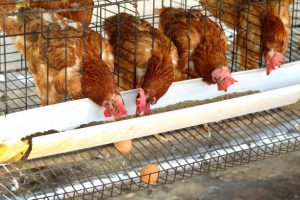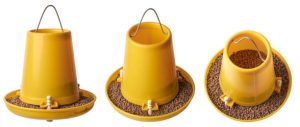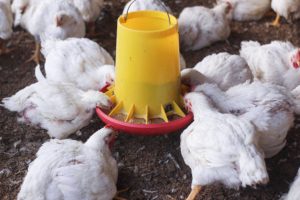As we therefore attempt to sew a chicken feeder the question may be asked, is it just a bowl or a container on the face of it? Absolutely not! It is crucial for a mother hen to choose right chicken feeders for her flock since it requires selecting the ideal one. The questions like “which chicken feeder should I get?” “Where should I place it?” “Will this feeder be adequate?” and “Is this material suitable?” are questions that need an answer before you make your purchase. Fortunately, we have created a holistic roadmap to assist you to overcome this significant decision-making process.
Key Takeaways
- Some of the most common feeders include the gravity feeder which is commonly used but quite slow to dispense the feed, treadle feeders which are fast but may allow the chickens to waste more feed, and the tube feeder which is a combination of both the gravity feeder and the treadle feeder.
- The advantages of buying automatic chicken feeders are that users can avoid physically feeding the birds, but each feeder type comes with its fair share of advantages and disadvantages; nowadays, there are many brands offering various features.
- Cooper, Gallagher, and Nicodemus (1997) established that the feeders differ from being made of plastic, metal, or wood – all with different properties such as durability and ease of cleaning in addition to cost.
- Selecting an appropriate feeder can be done based on the size and volume, ease of filling and sanitation practices as well as how sturdy it is to accommodate the chickens.
Types of Chicken Feeders
Choosing the right chicken feeder is essential for ensuring your flock’s health, reducing waste, and making your poultry care routine more efficient. Here’s a comprehensive guide to help you make the best choice.
Types of Chicken Feeders
1. Gravity Feeders

- Description: These feeders use gravity to dispense feed into a tray as the chickens eat.
- Pros: Simple design, easy to refill, reduces spillage.
- Cons: Can attract pests if not properly secured.
2. Treadle Feeders

- Description: Equipped with a step plate that chickens step on to open the feeder and access the food.
- Pros: Keeps feed clean and dry, prevents pests and wild birds from eating the feed.
- Cons: Can be expensive, chickens need to learn how to use it.
3. Hanging Feeders

- Description: Suspended off the ground, these feeders keep the feed elevated.
- Pros: Reduces spillage and contamination, can be easily adjusted for height.
- Cons: May swing if not properly secured, requiring regular refilling.
4. Automatic Feeders

- Description: These feeders dispense feed at set intervals or quantities.
- Pros: Saves time, ensures consistent feeding schedule.
- Cons: Can be costly, relies on power or batteries.
- Automatic feeders are ideal
5. DIY Feeders

- Description: Homemade feeders using materials like PVC pipes or buckets.
- Pros: Customizable, cost-effective.
- Cons: May require more maintenance, not as durable as commercial options.
Materials Used in Chicken Feeders
Chicken feeders can be purchased in many designs and styles, with the primary aspect to be considered being the type of material utilized in its construction. As depicted differently, these material has its own merits and demerit on the aspects of durability, on the ability to clean and on the environment of the bird population of your flock. Here’s a detailed overview of common materials used in chicken feeders:Here’s a detailed overview of common materials used in chicken feeders:
1. Plastic
Description
Plastic feeders are lightweight and come in a variety of shapes and sizes. They are often made from high-density polyethylene (HDPE) or similar durable plastics.
Advantages
- Lightweight: Easy to move and handle.
- Corrosion-Resistant: Does not rust or corrode, making it ideal for humid environments.
- Cost-Effective: Generally cheaper than metal feeders.
- Easy to Clean: Smooth surfaces make cleaning straightforward.
Disadvantages
- Durability: May crack or become brittle over time, especially when exposed to UV rays.
- Pest Attraction: Can be chewed by rodents if not properly secured.
2. Metal
Description
Metal feeders are typically made from galvanized steel or aluminum, offering a sturdy and long-lasting option. Galvanized steel feeders
Advantages
- Durable: Resistant to damage from pecking and weather conditions.
- Pest-Resistant: Hard for rodents to chew through.
- Long-Lasting: Can withstand heavy use and harsh environments.
Disadvantages
- Weight: Heavier than plastic, which can make them harder to move.
- Rust: Can rust if not properly treated or if the coating wears off.
- Cost: Generally more expensive than plastic feeders.
3. Wood
Description
Wooden feeders are less common but are sometimes used for DIY projects or rustic setups.
Advantages
- Aesthetic Appeal:Imitates natural feel, which can be easily integrated into gardens or farms where such vehicles are parked.
- Customizable: It is also easy to customize and can easily be made to address certain needs or be adapted to address different ones as well.
Disadvantages
- Durability:Can become worn out with time, and this is accelerated by use in areas with high humidity levels.
- Maintenance: Needs periodic use of antiseptic, and chemicals to avoid formation of rot or attacks by pests.
- Weight:They can be quite large and bulky to transport which could at times hamper their usage.
4. PVC
Description
Many PVC feeders are homemade using PVC pipes and connectors The reason for this is that PVC feeders are normally homemade using pipes and connectors made of PVC.
Advantages
- Durable:Non-corrosive and is not affected by the natural annual weathering.
- Customizable:
- Lightweight: Easier to handle and move compared to metal.
Disadvantages
- Aesthetic: May not look as attractive as other materials.
- Strength: Not as strong as metal, can be damaged if not properly supported.
Choosing the Right Material
When selecting a chicken feeder, consider the following:
- Environment: Choose corrosion-resistant materials for humid or rainy climates.
- Durability Needs: Metal may be better for larger, more aggressive flocks.
- Budget: Plastic and PVC tend to be more affordable options.
- Maintenance: Consider how easy it is to clean and maintain the material.
Choosing the Right Chicken Feeder
Before you make a particular purchase of a feeder for the chickens, there are some important considerations to make. Here are some things to keep in mind:Here are some things to keep in mind:
Size and Capacity Considerations
Selecting the right chicken feeders for your chickens is considered one of the most crucial steps in getting ready for your new role as a mother hen. And what if it is going to be not big enough? The size and capacity in the feeder must correspond to the number of chickens that is usually present. This is a disadvantage because a feeder that is smaller than the recommended size will need frequent replacement with fresh feed while a feeder that is larger than the optimal size will also see its feed go bad.
Ease of Cleaning
A feeder that is easy to clean will save you time and effort. Look for designs that allow for quick disassembly and reassembly. Ease of cleaning is crucial to maintain the health of your flock and to prevent mold and bacteria buildup.
Durability and Longevity
There is an element that should never escape the attention and consideration of any buyer and these include the cost of the feeders and the cost of chicken feeders. Of course, its functionality is important, there must be a feeder that is easy for the cleaning and it is made of rather durable material; however, the client does not need to pay a lot of money for this feeder.Therefore, it is important to auspect for good feeders in offering higher quality at a reasonable cost.
Installation of Chicken Feeders

Step-by-Step Installation Guide
When installing a chicken feeder, it is important to choose a location that is easily accessible to the chickens but also protected from the weather. The feeder should be placed on a level surface and secured to prevent tipping or spilling. Follow the manufacturer’s instructions for assembly and installation of the feeder.
- Choose a suitable location: Make sure the area or abode to be built is within reach of the chickens and protects them from unfavorable weather conditions.
- Assemble the feeder: It is advisable to heed to the directives provided by the manufacture since the instructions shall give clear guidelines on the proper manner in which the parts shall be installed.
- Secure the feeder: Put it on the flat ground and ensure that the item being moved does not tilt or fall over.
Tools Needed
- Screwdriver
- Wrench
- Level
- Measuring tape
Common Mistakes to Avoid
- Hanging the feeder in an unsheltered place or where they are directly nailed to the tree or post.
- Failure in fastening and securing the feeder enough to cause tipping or spilling over.
- Some of the hazards are as follows: Failure to adhere to the correct instructions provided by the
Maintenance of Chicken Feeders

However, it is crucial to understand how to care for chicken feeders so that the feeders will effectively serve their purpose in helping improve the health of the chickens. The buildup of dirt also cannot happen while under.Regular maintenance hence the control of mold and other bacteria and other micro organisms that are detrimental for our bodies. It recommended that feeders should be emptied and cleaned in at least a weekly basis, or in severe degree, more often. The feeder must also be checked often to ensure thieves or other creatures has not damaged it in its establishment; if there are breakages or gateways that have been created, then one has to repair those hitches as soon as possible or even get a new feeder. Make sure the feeder’s fasteners and connections are very sturdy so that there will not be an issue in feeding the animals in the feeder.
Benefits of Different Chicken Feeders
Advantages of Gravity Feeders
Taking the available chicken drinkers to farmers most of them prefer the gravity feeders. They also can also be purchased for relatively cheap prices and cannot really be compared to the efforts that is to be used on other equipment’s. Hence, it can be concluded that gravity feeders operates by a system whereby feed is positioned above the feeding tray and it falls slowly down into the feeding tray as the birds feed on it. Some of the benefits of using gravity feeders include:Advantages of the existence of ambition benefits that accrue with the use of gravity feeders are as follows:
- Consistent feeding schedule
- Reduced waste
- Can be used with different types of feed
Advantages of Automatic Feeders
There are several advantages of automatic chicken feeding system as listed below. They are helpful since they have mechanisms that dispense feed hence they do not require the human approach of feeding the animals many times within a day. They also assist in establishing a fixed feeding regime which is important in the health리 of the chickens. health of the chickens.
Some key advantages are:
- Time-saving
- Consistent feeding
- Reduced labor
Advantages of Tube Feeders
Compared with wing feeder, tube feeders are designed for minimizing feed loss and can be applied in even small and large poultry shelters. They can be easily refilled since they enable storage of large quantities of feed and therefore are not frequently utilized in refluxing. Benefits of tube feeders include:Advantages of these tube feeders are:
- Minimal feed waste
- Easy to refill
- Suitable for various flock sizes
Drawbacks of Different Chicken Feeders

Disadvantages of Gravity Feeders
It is important for chicken keepers to be aware of some of the limitations of using feeders such as the gravity feeders. Some of the drawbacks include:Some of the drawbacks include:
- • This makes it easy for feed to get contaminated particularly in those placed in a single container for a long time.
- • Extent to which it can attract rodents and other pests
- I have observed that chickens sometimes scratch the floor and drop feed as well.
Disadvantages of Automatic Feeders
So, despite the key advantage of using automatic feeders – convenience, they have their limitations as well. Some of the disadvantages of using automatic feeders include:Some of the disadvantages of using automatic feeders include:
- It is up to 15% more costly than other forms of feeders.
- May develop some issue, or even stop dispensing feed that plays a key role in feeding the livestock an average of 87, 150 kg per year.
- It has to be electrical energy or batteries as means of a power source.
Disadvantages of Tube Feeders
Disadvantages of Tube Feeders
It is mounted to feed to cut down wastage and is ideal irrespective of the number of birds as it can be applied in a small scale poultry business and a large one. Among the benefits are the fact that they come with lids and therefore will require frequent refilling; they are also very large and will be able to contain a lot of feed which will not compel the owner to fill them more often. Benefits of tube feeders include:The benefits of the tube feeders following the changes include the following:
- Limited capacity compared to other feeders
- Can be difficult to clean thoroughly
- May not be suitable for larger flocks
Overall, it is important to consider the benefits and drawbacks of different types of chicken feeders before making a decision. The best option will depend on individual needs and preferences.
Chicken Feeding Tips
Optimal Feeding Times routine is paramount in handling these animals and feeding them at the same time everyday is crucial. It’s preferable to make sure they have it throughout the day in the Morning and late afternoon This is helpful in enabling them to remain both healthy and fully functional in their working ability.
Preventing Feed Waste
Feed waste can be a significant issue if not managed properly. To minimize waste:
- Use feeders that are designed to reduce spillage.
- Avoid overfilling the feeders.
- Ensure the feeder is at the right height for your chickens.
Ensuring Nutritional Balance
This is a very important factor because diet should be balanced in order to have a healthy flock of birds. Ensure that you offer pellets of grains, protein and supplements in equal proportions. Ensure that the nutritional value of the feed that will be given to your chickens is reviewed periodically so that it reflects positions of all the mature phases of the chickens.
Location of Chicken Feeders
Choosing the right location for your chicken feeder is crucial for ensuring your chickens have consistent access to food while minimizing waste and protecting the feed from external factors. Where you place the feeder can significantly impact its effectiveness and longevity.
Cost Considerations
Initial Investment
When purchasing a chicken feeder, the initial investment can vary significantly based on the type and material of the feeder. For instance, a simple DIY operation for raising and butchering 50 broiler birds can cost around $1,600. On the other hand, the average cost for a larger, more complex system for 100 birds is considerably higher. It’s essential to balance quality and affordability to avoid overspending.
Long-term Costs
Here, long term costs consist of costs that would be incurred on account of maintenance, regular/occasional repairs and, at times, replacements. Other feeders can be mechanical and when this is the case, they may need the use of electricity or batteries in their functioning, a cost that will continue to reoccur. Furthermore, it could be argued that certain feeders are costlier than others and while the initial expense is higher, in time, a user might end up paying less as the feeder is designed to be both durable and efficient.
Cost-Benefit Analysis
Budgeting is of much help when trying to measure the overall value of the investment through the usage of cost benefits. Other parameters include time that is spent when feeding the animals, how much feed is squandered, and the durability of the feeder. Following this analysis, one will be in a position to make the right decision regarding the car in accordance with ones ability to afford the car or need to afford one.
Conclusion
At first, one might think that a chicken feeder refers to a simple bowl or a container that is filled with food — well, this is far from the truth! When it comes to your chickens, choosing the appropriate feeders is a significant decision any birding mother should make. Some of the questions that may need to be answered before the decision is made include: Which chicken feeder do I need to purchase? Should I get a large one or a small one? Where do you intend to fix it? Is it going to be larger enough to hold the food? Is the material used appropriate? Fortunately, we have gathered a collection of a compiled course that takes each of them step by step. guide to guide you through the different brands of chicken feeders and the types of materials that can be used in feeders From this article, you’ll learn about the various types of chicken feeders and their respective strengths and weaknesses. When choosing between the gravity feeders, treadle feeders, the tube feeders, and the automatic feeders, you should consider its size, the capacities, how it can be cleaned, and the durability, and how much it costs. Other important factors that can also be useful to understand are the proper fixing and also servicing frequently as well. After taking into account all these factors, one can offer the best feeding solution to his or her birds and they will always be healthy and happy.
Frequently Asked Questions
What is a chicken feeder?
A chicken feeder is essentially a vessel designed to hold feed for chickens. It ensures that the feed is accessible to the chickens while minimizing waste and preventing the feed from being contaminated.
What are the different types of chicken feeders available?
There are several types of chicken feeders available, including gravity feeders, treadle feeders, tube feeders, and automatic feeders. Each type has its own advantages and disadvantages.
How do I choose the right size feeder for my chickens?
Choosing the right size feeder depends on the number of chickens you have. Ensure that the feeder can hold enough feed to last at least a day and that multiple chickens can access it simultaneously without crowding.
What materials are commonly used in chicken feeders?
Chicken feeders are commonly made from plastic, metal, or wood. Each material has its own benefits, such as durability, ease of cleaning, and cost.
What are the benefits of using an automatic chicken feeder?
Automatic chicken feeders can save time and effort by dispensing feed at set intervals. They help ensure that chickens have a consistent supply of feed and can reduce waste by preventing overfeeding.
Where should I place my chicken feeder?
Chicken feeders can be placed either indoors or outdoors, depending on your setup. Ensure the location is dry, protected from the elements, and safe from predators.
How do I maintain my chicken feeder?
Regular maintenance includes cleaning the feeder to prevent mold and bacteria growth, checking for damage, and ensuring that moving parts (if any) are functioning properly. Seasonal maintenance might involve more thorough cleaning and repairs.
What are common mistakes to avoid when installing a chicken feeder?
Common mistakes include placing the feeder in an area prone to getting wet, not securing it properly, and not considering the height at which it is placed. Ensure the feeder is stable, accessible, and protected from the elements.